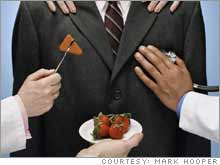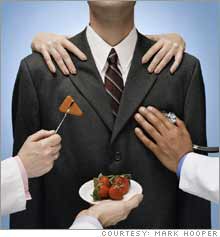|
The doctor will see you now A new breed of medical clinics can help busy entrepreneurs keep their health on track.
RICHMOND (FORTUNE Small Business Magazine) -- A bowl of broth - that was lunch the day I arrived in Richmond. For dinner, two bottles of lemon-flavored Fleet Phospho-soda and four bisacodyl tablets. You see where this is heading? I went to bed on an emptying stomach, slept fitfully, and woke at dawn feeling weak and lightheaded. By 7:30 A.M. I was in a hospital johnny, supine, my chest festooned with electrodes, my lower alimentary canal inflated like a balloon, as a gurney fed me headfirst into a $2 million GE-Imatron electron-beam tomography (EBT) scanner. Miserable and scared, in other words, and that was before I saw my test results. Premium care, premium price
PartnerMD, the party responsible for my suffering, is one of those new concierge medical clinics that cater to patients who are sick of HMOs and can afford better. For a $1,700 annual fee beyond the cost of care ("not a whole lot more expensive than premium cable," says PartnerMD CEO Linda Nash, not quite persuasively), you get appointments that begin as scheduled, ample face time with a doctor, and a holistic approach to medicine that emphasizes screening and prevention over disease management - and even house calls "when medically necessary," if you can believe that. Nash founded PartnerMD (partnermd.com) in 2003 with $650,000. In 2005 the company earned a small profit on revenues of $2.5 million and is projecting 50% top-line growth and higher profits in 2006. She hired two new doctors this spring - bringing the total to five - and says she's adding 30 to 40 new patients a month. If the concept appeals but you can't find a clinic in your town, then for about $4,000, depending on which tests you choose, you can sign up for a PartnerMD executive physical, as I did, and at least get a taste of the concierge treatment. Following my EBT scan, I pulled up my pants and staggered down the hallway to get my blood work done, after which, mercifully, nurse Amy showed me to my private office - outfitted with a high-back swivel chair, Internet access, and a radio pretuned to Lite 98 FM - where I feasted on nutty snacks and checked my e-mail. Time with the doc The actual physical exam, performed by nurse Amy and my doctor for the day, Jim Mumper, lasted a full hour. That kind of schedule works only because each PartnerMD physician has no more than 600 patients, compared with 3,000 or so for the average GP. Dr. Mumper joined me at noon for a catered lunch - a standard perk with every executive physical. I dined on roast pork and spinach salad while we discussed what sort of complaints bring business owners to the doctor's office. "It's what you would expect," Mumper explained. "Insomnia, sleep disturbances, chronic abdominal pain from irritable bowel syndrome, headaches, fatigue. I tell people all the time, the body doesn't like stress." Which is another way of saying the body doesn't like running a small business, or writing about it. The afternoon passed in a whirlwind of subappointments: an hour of strength and fitness testing with Rose (64 overall on a scale of 100; seems I'm not very flexible); a stress-management consultation with Sherry (among the findings: "Mr. Whitford has lots of things to do, and he cannot change that." Hmmm, anybody else feel that way?); nutrition counseling with Valerie; and the highlight of my day, a one-hour massage with Melissa. "You can turn over now, David," Melissa whispered in my ear at the halfway point. I was naked under a towel. The lights were dim. Soothing New Age music tinkled softly from the CD player in the corner. "Whatever you say, Melissa," I mumbled drowsily, "whatever you say." All in all, a wonderful day - except for the EBT scan and the story it told. EBTs are cutting-edge diagnostic tools that can detect tumors anywhere in the body and uncover hidden evidence of heart disease. The tests run about $400 and are usually not covered by health insurers. Test results do not diagnose According to Mumper, that's because too often EBTs reveal false positives - tumors that aren't really there - in which case you have to return for a follow-up scan just to make sure everything's okay. On the other hand, nearly everyone agrees that EBTs are very good at detecting coronary plaque, or atherosclerosis - especially in patients who seem perfectly fine (that is, until the moment they're not). I walk five miles every day, I'm not overweight, I haven't smoked cigarettes since college, and there are no scary diseases in my family history. Nevertheless, my EBT scan, while clean for polyps and tumors, revealed a calcium score in my left anterior descending coronary artery - the one that's nicknamed the "widow maker" because if it clogs, you can die - of 121.54. That would be a decent number for a 75-year-old (the range runs from zero to the low thousands), but I'm 49. Eighty-five percent of men my age have a lower score. "I wish it were zero, but it's good that we know," was Dr. Mumper's sober comment as he looked over my results. "That alone makes your trip down here worthwhile." Now, a calcium score in the moderate range, between 101 and 400, does not necessarily mean blockage. In fact, when I followed up back home with a stress test, doctors found no evidence of diminished circulation. I wish I could feel good about that. Unfortunately, the whole point of the calcium score is to measure the extent to which plaque has invaded the arterial wall before it causes tearing or blockage and makes my wife a widow. A widely cited study published in the journal Radiology in 2003 found a high correlation between "the extent of coronary calcium" - that's the calcium score - and "mortality risk." How high? My number means that while my overall risk profile remains very low, I'm four times more likely to drop dead within five years than someone whose calcium score is less than ten. What am I to do with such knowledge? I immediately asked my brother-in-law Ron for his advice. "It's bullshit!" he said. That's typical of Ron, a heart doctor who eats and drinks pretty much as he pleases, knowing, he says, that disease relates principally to one's genes. (When pressed, Ron said I could try drinking more; drunks often have exceptionally clean arteries.) Mumper was more sanguine. "We're going to come up with a drug in your lifetime that's going to make plaque go away," he promised. Until then, the best anyone can do is try to stop it from getting worse - and meanwhile address other, more responsive cardiac risk factors - through diet, exercise, and medication. Preventive intervention Long story short, I switched to oatmeal for breakfast; replaced red meat, white bread, and dairy with fish, whole wheat, and soy; swore off snacking at work; started swallowing multivitamins, fish-oil pills, and a daily low-dose aspirin; took up swimming twice a week at the Y; and stopped worrying about how much wine I was drinking. As if by magic, I lost 15 pounds in three weeks. Two months later, I repeated the blood work and the news was good. My LDL (bad cholesterol), formerly 176, was now 116; my HDL (good cholesterol) had risen from 66 to 80; and my total cholesterol had dropped from 266 to 211. That was still a tad high, given my risk profile, so my home doctor put me on statins, and when I followed up again four months later, the news was even better: LDL, 54; HDL, 82; and total cholesterol, 145. "These readings are great," my doctor gushed. Thanks to my fancy physical, I'm now aware of certain imperfections in my aging physical plant: probable calcification on the right lobe of my prostate gland; a heart murmur; atypical nevi (moles); tinea versicolor (skin fungus); and the two biggies, hyperlipidemia (high cholesterol) and atherosclerotic coronary artery disease. Knowing all that, I've taken reasonable steps to improve my odds. But how worried should I be, really? I've got numbers now that I didn't have before. What I'll never have is certainty. "Don't worry," says the other doctor in my family, Ron's daughter Henya. "Your blood pressure is fine, your good cholesterol is high, you'll be fine. And one day you'll probably die of heart disease, like most of us will." I guess I can live with that. The best test for early detection of heart disease? Find out now. Home HIV tests pending FDA approval. Click here. |
|


